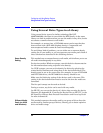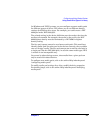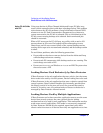
Configuring and Using Backup Devices
Shared Devices in the SAN Environment
Chapter 246
Using FC-AL SANs
with LIP
Using tape devices in Fibre Channel Arbitrated Loops (FC-ALs) may
cause certain anomalies that could abort a backup session. This problem
arises because the FC-AL performs a Loop Initialization Protocol (LIP)
whenever a new FC link is connected or disconnected, or whenever a
system connected to the FC-AL is rebooted. This re-initialization of the
FC-AL causes running backups to be aborted. Such terminated jobs
should be restarted.
When a LIP occurs on the FC-AL Loop, any utility with an active I/O
process shows an I/O error. For backup utilities attempting to use a
shared tape, an I/O error causes failure of the current backup session,
causing active tapes to be rewound and unloaded, and the backup session
to abort.
To avoid these problems, take the following precautions:
• Do not add new devices or remove devices from the Arbitrated Loop
while backup sessions are running.
• Do not touch FC components while backup sessions are running. The
static charge can cause a LIP.
• Do not use discovery on Windows or ioscan on HP-UX system since
these also cause a LIP.
Locking Devices Used Exclusively by Data Protector
If Data Protector is the only application that uses a drive, but that same
drive needs to be used by several systems, Device Locking has to be used.
If Data Protector is the only application that uses a robotics control from
several systems, Data Protector handles this internally, provided that
the library control is in the same cell as all the systems that need to
control it. In such a case, all synchronization of access to the device is
managed by Data Protector internal control.
Locking Devices Used by Multiple Applications
If Data Protector and at least one other application want to use the same
device from several systems, the same (generic) device locking
mechanism has to be used by each application. This mechanism needs to
work across several applications. This mode is not currently supported
by Data Protector. Should this be required, operational rules must
ensure exclusive access to all devices from only one application at a time.


















